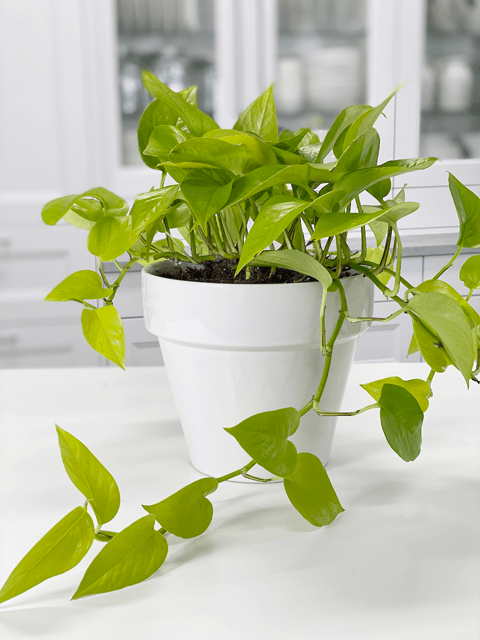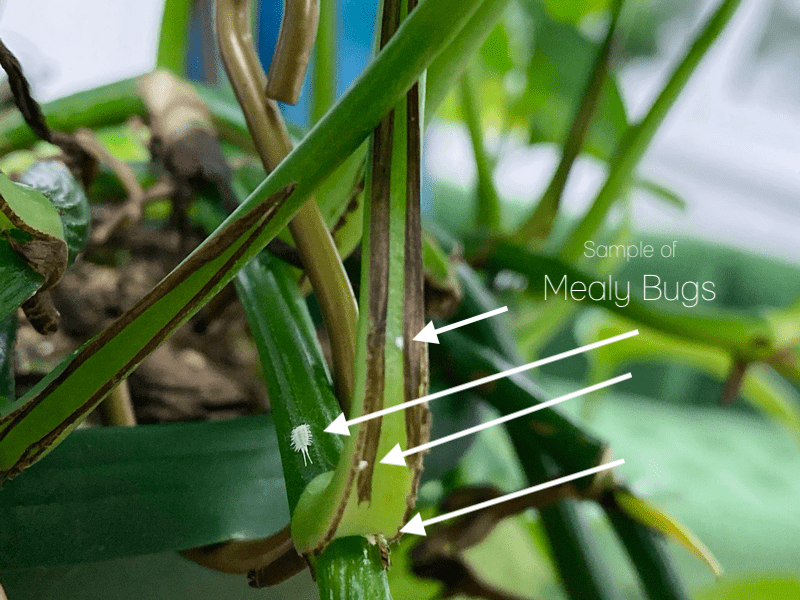

 Add to favorites
Add to favorites
Neon pothos (Epipremnum aureum ‘Neon’) is one of the most distinct varieties of this plant. Its heart-shaped leaves are bright chartreuse or golden yellow in color with no variegation. The newer, younger leaves tend to be brighter than older leaves. The foliage deepens in color with age. To get the best color, grow neon pothos in bright light. In low-light spots, the color will be duller and darker.

The neon pothos looks great grown in containers and hanging baskets. I love intermixing it with my other plants due to its wonderful color contrast. This wasn’t always the case– at first, I was turned off by their bright yellow/green color, but once I started grouping plants, I found that the contrast to other green plants created a lush look.
These plants are native to French Polynesia and when grown in their natural habitat, the leaves of a mature plant can grow to be longer than 3 feet. The leaves, not the vines! I can hardly wrap my head around that. I only have a couple of these plants, as they seem to be challenging to find in my local area. But that’s okay… hard to find plants come with greater appreciation.
The neon pothos thrives in medium to low indirect light. It is not suited for intense, direct sun.
 Water Requirements
Water RequirementsPothos plants perform best when they are watered regularly and when you allow the soil to dry somewhat between waterings. Don’t worry if you forget—it will occasionally tolerate a missed watering! BUT I don’t recommend doing this too often, as it might stress the plant.
Water every week or two, depending on the season. I find that my plants require less watering during the winter months, since most indoor plants go dormant. Of course, this all depends on where you live.
Here in Oregon, we experience four seasons and our winters can be rather warm. It’s also good to note that smaller potted plants will require more watering, since there isn’t much soil to hold moisture.
Personally, I let my pothos plants dry out to about 75% in between waterings. When I do water them, I take them to the sink and soak them all the way through until water runs out of the base of the pot.
The neon pothos prefers average to warm temperatures of 60 to 80 degrees (F) degrees. Do not expose it to temperatures below 60 degrees even for a short time, because cold air will damage the foliage. Avoid cold drafts and heat vents.
Feed monthly, spring through fall, with general-purpose indoor plant fertilizer. Advice about how often to feed houseplants is all over the board. If you overfeed your plants, they will let you know. Here are a few things to watch for:
If you overfeed a plant, you can remove it from its current soil and repot it in fresh soil. This is undoubtedly the best way to get rid of the excess nutrients affecting your plant. Alternatively, you can flush the soil, which involves drenching the soil with water and letting it drain out. Repeat this several times to help the soil get rid of excess fertilizer.
If you want to have healthy houseplants, you MUST inspect them regularly. Every time I water a plant, I give it a quick look-over. Bugs/insects feeding on your plants reduces the plant sap and redirects nutrients from leaves. Some chew on the leaves, leaving holes in the leaves. Also watch for wilting, yellowing, distorted, or speckled leaves. They can quickly get out of hand and spread to your other plants.
IF you see ONE bug, trust me, there are more. So, take action right away. Some are brave enough to show their “faces” by hanging out on stems in plain sight. Others tend to hide out in the darnedest of places, like the crotch of a plant or in a leaf that has yet to unfurl.

Diagnosing what is going wrong with your plant is going to take a little detective work, but even more patience! First of all, don’t panic, and don’t throw out a plant prematurely. Take a few deep breaths and work down the list of possible issues. Below, I am going to share some typical symptoms that can arise.
When I start to spot troubling signs on a plant, I take the plant into a room with good lighting, pull out my magnifiers, and start by thoroughly inspecting the plant.
Brown Leaf Tips
Pale/Yellow Leaves
Your plant will benefit from occasional pruning, which helps it to branch out and become fuller. Spring is the best time to cut it back. Use sharp pruners to avoid tearing the stems. I love the idea of pruning (cutting back vines) but I’ll be darned if I don’t tremble when holding the scissors! The payoff is rewarding (in time) but it feels like I am cutting my own hair which took too long to grow out. Are you feeling me?
Pothos are mildly toxic to pets and humans if ingested. It can cause a mild irritation to the mouth if chewed or swallowed and also a mild digestive reaction. It may also cause skin irritation. Keep the plant out of reach of animals and kiddos.
Love all the info!!
Thank you Chris. Are you an avid plant grower/lover?
Yes I am! Love my plants.
Hi Amie,
Thanks for such an amazing post. I recently bought this amazing plant for my office as it truly caught my eye. On that I have a question…My office though well lit, does not have a window. What do you think is the best thing to do to make sure it gets the lighting needed to thrive? Thank you kindly in advance.
Hello Daniel,
I would purchase some grow light bulbs that you can put in lamps that can either be put over the plant or pointing towards it. Also, I assume you don’t work 7 days a week… will your plant be in total darkness when you are not there? If so, or even in general, you can purchase an adapter to plug into the socket that the lamp can plug into that has a timer that you can set on it. I hope that helps. blessings, amie sue
Hi Amie. Thank you for your prompt response. This is what I have done…I have put a led light lamp pointing towards it for when I’m not in the office. While I’m in the office I just use the overhead headlight and turn off the led light lamp. Hoping this would do the trick.
You are welcome Daniel. I’ve never used red light for plants but if it works… it works! The overhead light should be fine. Always remember some plants due fine if “low light” but they always do better in full in-direct light. I have plants all over my house, all living in various light situations. Those that get more nature light, grow faster… but that doesn’t always have to be the goal. We just want happy, healthy plants. :) many blessings, amie sue
What about the roots of the neon pothos I have root rotting it was like that when I got it now they all die I tried to save it . But what can I do to re grow some of them.
Good day, Denise,
Oh no—I’m so sorry to hear about your plant! That’s always so disappointing.
The best thing to do at this point is to take cuttings—in fact, I’d recommend cutting the whole plant back to propagate the healthy leaves. Just be sure to cut just below a node, as that’s where new roots will begin to form.
If you’re unsure how to propagate, I’d be happy to walk you through the process. I don’t want to take up your time if you’re already familiar with it, so just let me know.
Wishing you the best of luck! amie sue